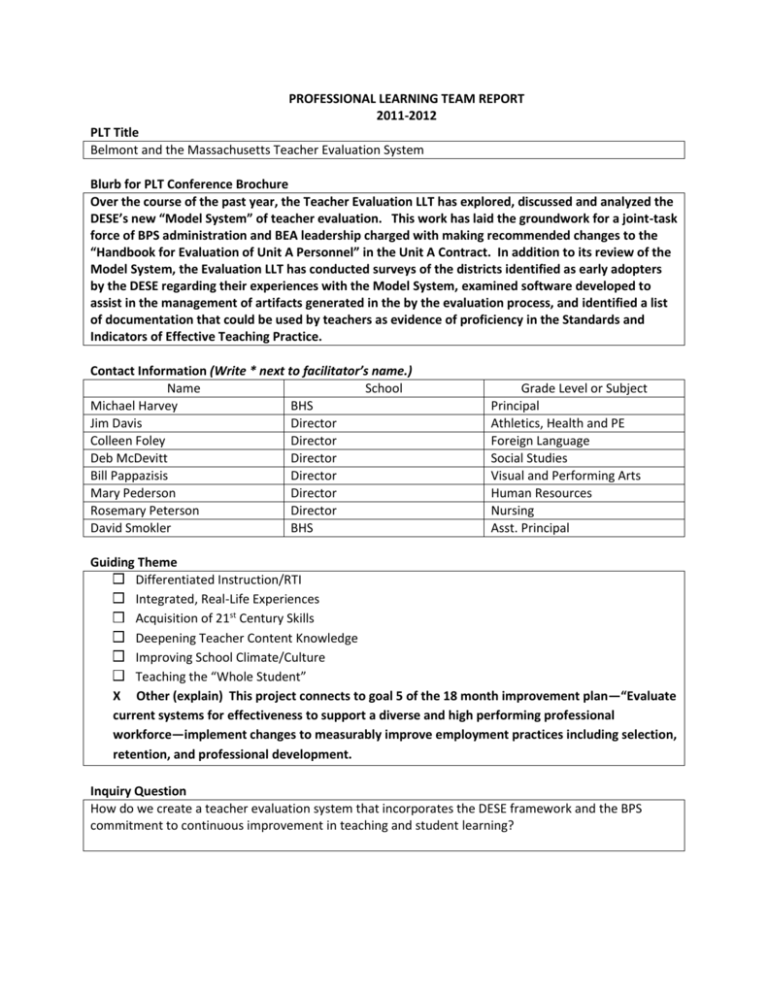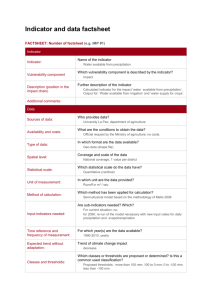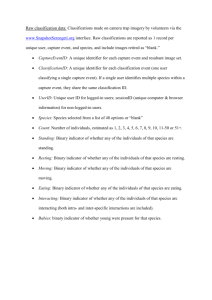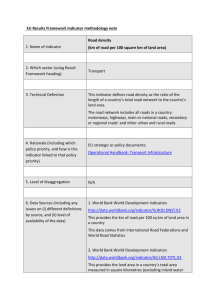Belmont and the Massachusetts Teacher Evaluation System
advertisement

PROFESSIONAL LEARNING TEAM REPORT 2011-2012 PLT Title Belmont and the Massachusetts Teacher Evaluation System Blurb for PLT Conference Brochure Over the course of the past year, the Teacher Evaluation LLT has explored, discussed and analyzed the DESE’s new “Model System” of teacher evaluation. This work has laid the groundwork for a joint-task force of BPS administration and BEA leadership charged with making recommended changes to the “Handbook for Evaluation of Unit A Personnel” in the Unit A Contract. In addition to its review of the Model System, the Evaluation LLT has conducted surveys of the districts identified as early adopters by the DESE regarding their experiences with the Model System, examined software developed to assist in the management of artifacts generated in the by the evaluation process, and identified a list of documentation that could be used by teachers as evidence of proficiency in the Standards and Indicators of Effective Teaching Practice. Contact Information (Write * next to facilitator’s name.) Name School Michael Harvey BHS Jim Davis Director Colleen Foley Director Deb McDevitt Director Bill Pappazisis Director Mary Pederson Director Rosemary Peterson Director David Smokler BHS Grade Level or Subject Principal Athletics, Health and PE Foreign Language Social Studies Visual and Performing Arts Human Resources Nursing Asst. Principal Guiding Theme Differentiated Instruction/RTI Integrated, Real-Life Experiences Acquisition of 21st Century Skills Deepening Teacher Content Knowledge Improving School Climate/Culture Teaching the “Whole Student” X Other (explain) This project connects to goal 5 of the 18 month improvement plan—“Evaluate current systems for effectiveness to support a diverse and high performing professional workforce—implement changes to measurably improve employment practices including selection, retention, and professional development. Inquiry Question How do we create a teacher evaluation system that incorporates the DESE framework and the BPS commitment to continuous improvement in teaching and student learning? Process Conduct surveys of the districts identified as early adopters by the DESE regarding their experiences with the Model System, Examined software developed to assist in the management of artifacts generated in the by the evaluation process, and Identify a list of documentation that could be used by teachers as evidence of proficiency in the Standards and Indicators of Effective Teaching Practice. Findings Adoption of the DESE Model System seems to be the most popular method among school systems that did not already have a rubric-based evaluation system in place and were still following the Saphier Model of Teacher Evaluation. Most software packages developed to assist with implementation of Model System were very rudimentary or were developed for other states and adopted to fit Massachusetts’ Model. There are many different ways that teachers can demonstrate proficiency in a specific standard. The list developed by the LLT is attached to this document. Recommendations / Next Steps Implement full adoption of DESE Teacher Evaluation System for a one year pilot program. Continue meetings of Joint-Task Force of BPS Administration and BEA Representatives to share feedback from teachers and administrators regarding the adoption of the model system Decide on changes for the second year of implementation of the system. Identify appropriate technological systems to assist in the creation of a teacher portfolio. List of Examples of Evidence for Each Standard Standard I: Curriculum, Planning, and Assessment. The teacher promotes the learning and growth of all students by providing high-quality and coherent instruction, designing and administering authentic and meaningful student assessments, analyzing student performance and growth data, using this data to improve instruction, providing students with constructive feedback on an ongoing basis, and continuously refining learning objectives. Indicator I-A. Curriculum and Planning: Knows the subject matter well, has a good grasp of child development and how students learn, and designs effective and rigorous standards-based units of instruction consisting of well-structured lessons with measurable outcomes. Collection of grade level lesson and unit plans Video recording of an actual lesson and or lessons by the educator Documentations such as check list, pre & post assessment tools, inquiry questions, etc. that identifies the connection to both the State standard & BPS Benchmark it is targeted to. Daily plan book with self reflective feedback notes on how the lesson went, adjustments that need to be made, student’s readiness to learn, for each section / class. Active participation in department curriculum review/ development work & discussion Indicator I-B. Assessment: Uses a variety of informal and formal methods of assessments to measure student learning, growth, and understanding to develop differentiated and enhanced learning experiences and improve future instruction. Formative Assessment : Collection of anecdotal records, periodic quizzes or essays, diagnostic tests and in-class or homework assignments Summative Assessment: Collection of various unit tests, department exams, position paper, final project Selected Response Assessment: Multiple choice, fill-in-the-blank, matching and true/false questions Constructed Response Assessment: Students to generate their own response rather than selecting a single response from several possible ones Performance Assessment Portfolio Assessment Observational Assessment Indicator I-C. Analysis: Analyzes data from assessments, draws conclusions, and shares them appropriately. MCAS scores and related lesson plans to address low areas Agendas for meetings where student work was analyzed Assessments- original and one with modifications if the results on the first assessments were not desired Any emails sent to colleagues or families discussing student results on assessments and appropriates supports and or strategies to help improve student progress A meeting schedule for times dedicated to share and analyze students work and draw conclusions Progress report print-outs with constructive advice to improve student performance Standard II: Teaching All Students. The teacher promotes the learning and growth of all students through instructional practices that establish high expectations, create a safe and effective classroom environment, and demonstrate cultural proficiency. Indicator II-A. Instruction: Uses instructional practices that reflect high expectations regarding content and quality of effort and work; engage all students; and are personalized to accommodate diverse learning styles, needs, interest, and levels of readiness. Course policies sheet with expectations for quality of work and student engagement Copies of assessments that provide exemplars Rubrics for assignments Rubrics for participation and effort Examples of reward systems (to motivate and promote student engagement) Lesson plans which demonstrate a variety of instructional strategies Examples of projects or larger assignments that have instructions broken down Examples of a variety of assignments that provide many different opportunities for students of various learning styles, needs, and interest to demonstrate their knowledge. Indicator II-B. Learning Environment: Creates and maintains a safe and collaborative learning environment that motivates students to take academic risks, challenge themselves, and claim ownership of their learning. Classroom expectations for student behavior Rubric / guidelines for class participation Rubric / guidelines for group work Student reflections on their work Teacher uses strategies such as "turn and talk" "think, pair, share" Student goal setting activities Survey results from students (beginning and end of year) regarding classroom climate and learning. Indicator II-C. Cultural Proficiency: Actively creates and maintains an environment in which students’ diverse backgrounds, identities, strengths, and challenges are respected. Classroom expectations for student behavior Activators that draw on students' background and identities Classroom conflict resolution guidelines Survey results from students (beginning and end of year) regarding classroom climate and learning. Participation in a workshop or class that expands teachers' knowledge of students’ diverse backgrounds, identities, strengths, and challenges are respected. Integrating students' backgrounds into the curriculum through classroom visitors, lessons or projects. Indicator II-D. Expectations: Plans and implements lessons that set clear and high expectations and also make knowledge accessible for all students. Lesson plans contain clear objectives. Walkthroughs note teachers begin lessons by presenting objectives to students. Lesson plans demonstrate a level of rigor that is appropriate for age/grade level of students. Teacher attends a workshop on differentiation of instruction. Teacher takes a graduate course on educating students with learning difficulties. Standard III: Family and Community Engagement. The teacher promotes the learning and growth of all students through effective partnerships with families, caregivers, community members, and organizations. Indicator III-A. Engagement: Welcomes and encourages every family to become active participants in the classroom and school community. Teacher writes a welcome letter to all families in class in September. Teacher keeps a log of parent volunteers in the classroom. Teacher writes a personal note to families inviting them to conferences, or other specific classroom events. Teacher identifies families whose primary language is not English and makes arrangements for communications to be sent in their native language. Teacher keeps a phone/email log of positive contact with parents. Indicator III-B. Collaboration: Collaborates with families to create and implement strategies for supporting student learning and development both at home and at school. Through a weekly published e-newsletter, the teacher provides parents with upcoming major learning goals in each of the core subjects, homework assignments, and suggested resources that parents can use at assist and enhance learning at home. Provide regular one-on-one feedback to parents of children with disabilities or who have limited English proficiency with specific content or skills-based resources, strategies for completing assignments that address the specific needs of the student. Use Edline to post weekly learning objectives, assignments, and resources for parents that can be used at home with the student. Develop a blog to enhance communication between the classroom and home that provides the teachers with an opportunity to connect with parents about curriculum, classroom happenings and resources, and provides parents with an opportunity to ask questions, and share their resources, and “things that work in my house” with other parents in the class. Regular phone calls home to discuss individual student’s progress and needs. Indicator III-C. Communication: Engages in regular, two-way, and culturally proficient communication with families about student learning and performance. Maintain a log and collection of emails to individual parents that demonstrate frequent and regular communication home. Survey parents on communication style, clarity and substance of communication; show how the results were used to inform the teacher’s practices relative to this indicator. Video record a sampling of parents conferences; analyze for communication style, clarity and substance, and perhaps invite a colleague to provide you with some analytical feedback; re-record to demonstrate improvement relative to the indicator. Standard IV: Professional Culture. The teacher promotes the learning and growth of all students through ethical, culturally proficient, skilled, and collaborative practice. Indicator IV-A. Reflection: Demonstrates the capacity to reflect on and improve the educator’s own practice, using informal means as well as meetings with teams and work groups to gather information, analyze data, examine issues, set meaningful goals, and develop new approaches in order to improve teaching and learning. Teacher develops SMART Goals through the Evaluation System. Teacher keeps a journal documenting progress in achieving SMART Goals. Teacher creates a “data binder” of student assessment data. Grade/subject area teams conduct data analysis meetings and develop student learning goals based on the deficiencies identified in the data. Teacher documents Professional Learning Team progress towards achieving a student learning goal. Indicator IV-B. Professional Growth: Actively pursues professional development and learning opportunities to improve quality of practice or build the expertise and experience to assume different instructional and leadership roles. Participation in a state-approved Leadership Licensure Program. Successful completion of graduate courses in teaching pedagogy. Successful completion of a Professional Learning Team project. Documentation of attendance at a national, state or local conference. Documentation of supervision of a student teacher. Documentation of serving as a mentor for a new teacher. Indicator IV-C. Collaboration: Collaborates effectively with colleagues on a wide range of tasks. Teacher keeps a log of grade/subject level team meetings. Teacher keeps a portfolio of group-developed lesson plans. Surveys of members of teacher’s PLT reflect positive collaboration. Indicator IV-D. Decision-Making: Becomes involved in school-wide decision making, and takes an active role in school improvement planning. Teacher joins School Advisory Council and keeps a log of meetings. Teacher volunteers for school-wide task force groups and keeps a log of meetings. Indicator IV-E. Shared Responsibility: Shares responsibility for the performance of all students within the school. Copies of discipline referrals to demonstrate consistent enforcement of school behavior expectations. Demonstrated participation in groups of teachers looking at student work to determine benchmarks for learning expectations. Proof of use of report card comments that refer to the learning goals of the school and district. Copies of common assessments aligned to specific learning expectations. Copies of feedback given to students that align with school-wide learning expectations. Indicator IV-F. Professional Responsibilities: Is ethical and reliable, and meets routine responsibilities consistently. Written evaluation reports from directors/supervisors. Attendance data. Copies of course expectation sheets that refer to integrity, honesty, or fairness. Written reflection about judgment using a specific example that demonstrates good judgment and ethics. Completed training on ethics for public employees.








